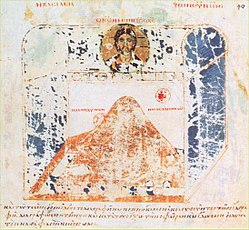Flat Earth

The flat earth theory is a scientifically false hypothesis that says the surface of the Earth is not roughly a sphere, but rather flat (a plane).
History
Ancient history
Belief in a flat Earth is found in writings predating 500 BC. Early Mesopotamian maps showed the world as a flat disk floating in the ocean.
This was a common belief until the Classical Greeks began to discuss the Earth's shape about the 4th century BC. One of the "giveaways" is that ships' masts disappear last as they move away from shore. By 330 BC, Aristotle knew the Earth was round, that is to say, roughly spherical.
Eratosthenes (276 BC–194 BC) calculated the circumference of the Earth quite well.[1] From then on, few educated people ever believed it was flat, though many less educated people still thought the earth was flat.[2]
The large-scale shape of the Earth only matters when considering large distances, as it is hard to see the Earth's curve from the ground. Therefore in the Ancient world only sailors, astronomers, philosophers, and theologians would have cared about the Earth's large-scale shape.
The following authors argued for a spherical or ball-shaped earth: King Alfred of the Anglo-Saxons, Hildegard von Bingen, Thomas Aquinas, Snorri Sturluson, Marco Polo, Dante Alighieri, Christopher Columbus
Final proof in the 16th century
Just before and during the 16th century, Portuguese people explored Africa and Asia; Christopher Columbus sailed to the Americas in 1492); and Ferdinand Magellan circumnavigated (sailed all the way around) the earth between 1519-1521). This proved finally, and in a practical way, that the Earth is a globe.
19th century revival
During the 19th century, the Romantic belief about a European "Dark Age" made the Flat Earth model look more important than it ever had in history.
In 1849, the Flat Earth movement was revived by Samuel Rowbotham, who wrote the book Zetetic Astronomy. He claimed his Bedford level experiment proved that the earth was flat.[3]
Today
People who believe in a flat earth exist today. For example, the Flat Earth Society is an active organization with a website, Facebook page, and Twitter account.[4]
In art & literature
The Flammarion woodcut
The Flammarion woodcut illustrates a medieval missionary's claim: that "he reached the horizon where the Earth and the heavens met". The woodcut shows a man poking his head through the firmament of a flat Earth to see machines working the spheres.
It was made in 16th century style, and an unproven story says Flammarion ordered it himself. However, it cannot be traced farther back than Camille Flammarion's 19th-century book L'Atmosphère: Météorologie Populaire (Paris, 1888, p. 163). Additionally, the original woodcut had a decorative border that places it in the 19th century.
In later publications, some claimed that the woodcut dated from the 16th century and the border was removed.
In literature
An early mention in literature was Ludvig Holberg's comedy Erasmus Montanus (1723). A great many people disagree with Erasmus Montanus when he claims the Earth is round, since all the peasants believe it is flat. He is not allowed to marry his fiancée until he cries "The earth is flat as a pancake".
In Rudyard Kipling's The Village that Voted the Earth was Flat, the main characters spread a rumor that a Parish Council meeting had voted in favor of a flat Earth.
Myth of the flat earth
The myth of the flat Earth, or the flat earth error, claims that European scholars and educated people during the Middle Ages believed the Earth to be flat.[5][6] This is not true.[5][6]
Fantasy fiction


Fantasy fiction often imagines a flat Earth. In C. S. Lewis' The Voyage of the Dawn Treader the fictional world of Narnia is "round like a table" (i.e., flat), not "round like a ball", and the characters sail toward the edge of this world.
Terry Pratchett's Strata and Discworld novels (from 1983 onwards) are set on a flat, disc-shaped world resting on the backs of four huge elephants which are in turn standing on the back of an enormous turtle.
Flat Earth Media
Flat Earth map drawn by Orlando Ferguson in 1893. The map contains several references to biblical passages as well as various supposed refutations of the "Globe Theory".
Imago Mundi Babylonian map, the oldest known world map, 6th century BC Babylonia.
Illustration based on that of a 12th-century Asian cosmographer
Semi-circular shadow of Earth on the Moon during a partial lunar eclipse
An image of Thorntonbank Wind Farm (near the Belgian coast) with the lower parts of the more distant towers increasingly hidden by the horizon, demonstrating the curvature of the Earth
Cosmas Indicopleustes' world view – flat Earth in a Tabernacle
12th-century T and O map representing the inhabited world as described by Isidore of Seville in his Etymologiae (chapter 14, de terra et partibus)
Related pages
References
- ↑ Asimov, Isaac. 1975. Asimov's biographical encyclopedia of science and technology, entry #42, "Eratosthenes", p. 29. Pan Books, London. ISBN 0-330-24323-3
- ↑ Gould, Stephen Jay 1996. The late birth of a flat Earth. In Dinosaur in a haystack. London: Penguin, p38. ISBN 0-14-025672-5
- ↑ Samuel Birley Rowbotham (1865). Zetetic astronomy. Earth not a globe! an experimental inquiry into the true figure of the earth ... Oxford University.
- ↑ "The Flat Earth Society". theflatearthsociety.org. Retrieved 2025-04-09.
- ↑ 5.0 5.1 *Russell, Jeffrey Burton (1991), Inventing the Flat Earth: Columbus and modern historians, New York: Praeger, ISBN 0-275-95904-X
- ↑ 6.0 6.1 *Russell, Jeffrey Burton (1993), "The Flat Error: The Modern Distortion of Medieval Geography", Mediaevalia, 15: 337–353










